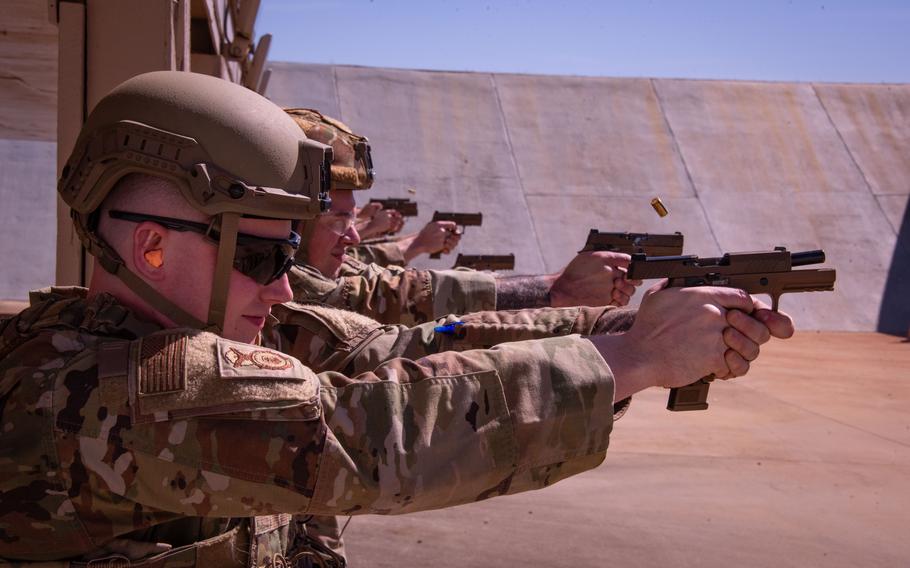
Air National Guard airmen fire 9mm rounds from an M18 handgun at paper targets, during training at McGhee Tyson Air National Guard Base, Tenn., on March 1, 2025. (U.S. Air National Guard photo)
Air Force Global Strike Command is returning the M18 pistol to duty after pausing use of the firearm for more than a month following the shooting death of a security forces airman, service officials announced Monday.
Gen. Thomas Bussiere, who leads Global Strike Command, signed off on the return to duty for most of the command’s Sig Sauer-made sidearms after a weekslong inspection of all its 7,970 M18s, the command said in a statement. The general determined the vast majority of the guns were safe to return to duty.
“It is paramount that our airmen trust their weapon systems,” Bussiere said in a prepared statement. “This thorough inspection ensures the M18s in our inventory are in optimal working order, providing our [security forces] defenders with safe, reliable and effective systems to accomplish their mission.”
Bussiere ordered the pause in use of the M18s after 21-year-old Airman Brayden Lovan, a security forces specialist at F.E. Warren Air Force Base, Wyo., was fatally shot by another airman on July 20. Investigators were initially concerned an M18 had discharged without its trigger being pulled — a rare occurrence known as an “uncommanded discharge.”
Such discharges had been reported previously by Sig Sauer-made pistols similar to the M18, which is a compact version of the New Hampshire-based firearm maker’s P320 model. Sig has faced more than a dozen lawsuits in recent years from law enforcement officers and civilians who have claimed their P320s have fired without a trigger pull, in some cases causing injuries.
Sig Sauer has long argued that none of its weapons are capable of firing on their own, but the company said it would support the military investigations into the M18’s safety. Sig has supplied the military with M18s and their full-size version M17s since winning a contract in 2017 to replace the decades-old M9 pistol built by Beretta.
Air Force investigators appear to have ruled out an “uncommanded discharge” in Lovan’s death. On Aug. 8, the service announced an airman had been arrested in the case and charged with making false statements, obstructing justice and involuntary manslaughter.
The Air Force has yet to name the airman accused in Lovan’s death because of the ongoing investigation, a service spokesman said Monday.
Officials also said a thorough review of M18 discharges across Global Strike Command showed none had occurred without a trigger pull.
The inspection of Global Strike Command’s M18s, which later expanded to all of the Air Force’s about 125,000 M18 pistols, did find issues with some of its sidearms, service officials said.
Inspections found problems with 191 of the command’s M18s, most of which were problems with “component wear,” according to the Air Force. Most of the issues were related to wear on the M18s safety levers, on their striker assemblies and on their sears. Strike assemblies are the spring-loaded mechanisms that impact a cartridge’s primer to fire the weapon, and sears hold back the striker until the trigger is pulled.
“Weapons exhibiting these discrepancies were immediately tagged and are undergoing necessary repairs,” the service said.
The command is adding “enhanced inspection procedures” for its M18 inventory, which will include new inspection criteria of those parts of the M18 found to wear the fastest, said Lt. Col. George Hern, Air Force Global Strike Command’s security forces commander.
“By incorporating these added measures, we assess that any issues found with the safety lever, striker assembly and sear will be identified during semiannual and annual inspections,” he said. “As we execute M18 inspections in the future, we will be taking a particular interest in these components to ensure these methods address the issues we found and make adjustments as needed.”
The command is also enlisting the top officers and enlisted leaders in its security forces squadrons to brief airmen on the findings of the M18 inspections, introduce them to the new enhanced inspections and reinforce basic weapons safety including muzzle discipline, according to the Air Force.
“When we see a potential issue, we have a responsibility to our airmen and the American public to evaluate, find any discrepancies and act on them,” Bussiere said.